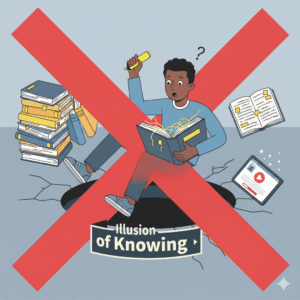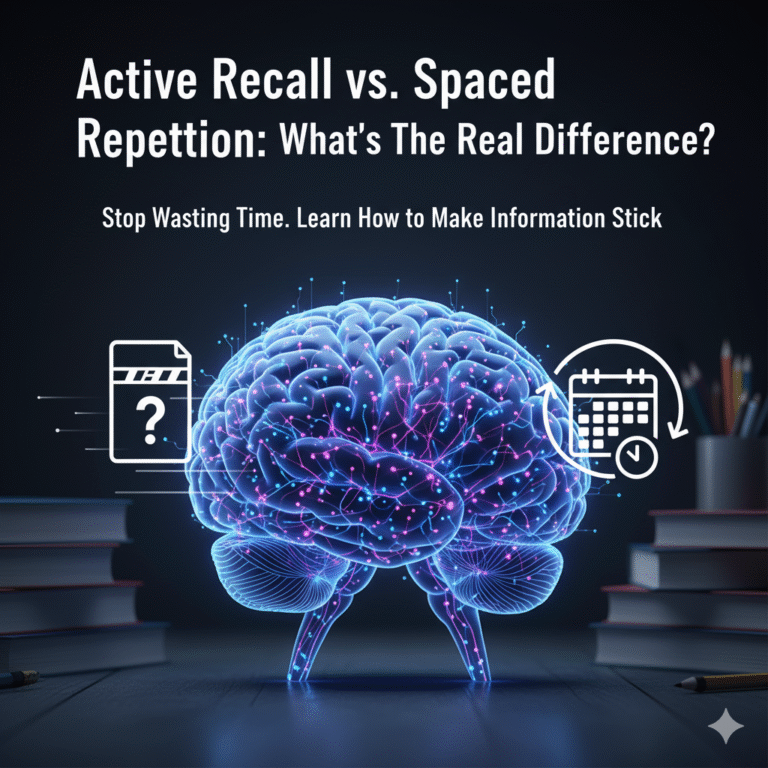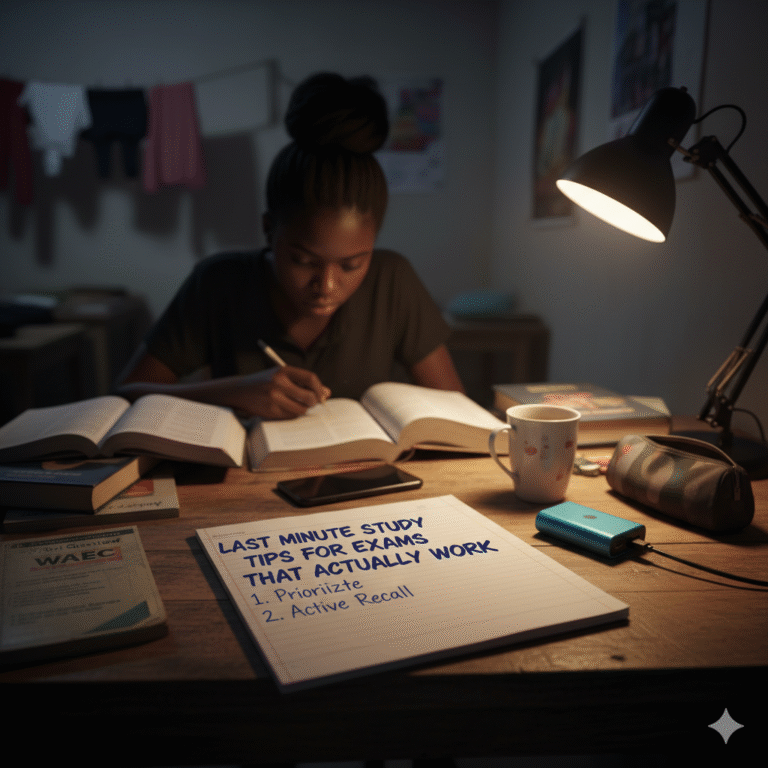Active Recall vs Passive Recall: Why Your Old Study Method Is Useless
Active Recall vs Passive Recall: Why Your Old Study Method Is Useless
Ever stare at your textbook for an hour, reading the same page over and over, only to realize nothing actually entered your brain?
I get it. We’ve all been there. You highlight, you read, you even make pretty notes. But when you get to the exam hall, your mind just goes blank.
Here’s the truth: you’ve been studying wrong. The big debate of active recall vs passive recall isn’t really a debate at all. One method is a powerful tool for memory, and the other is mostly a waste of your time.
In this post, I’ll break down the difference, show you exactly how to use active recall, and explain the common mistakes that stop most students from seeing results.

What is Passive Recall (And Why Is It a Trap)?
Passive recall (or passive review) is what you think studying is.
It’s reading your textbook. It’s highlighting sentences. It’s re-watching a lecture video. It’s neatly re-writing your notes.
It feels good, right? It feels productive. But here’s the problem: passive recall only creates an illusion of knowing.
Your brain gets good at recognizing the information. You see the words on the page and think, “Ah yes, I know this.” But recognizing isn’t the same as remembering.
It’s the fastest way to get to the exam hall and blank out.

What is Active Recall (The ‘Smarter’ Way to Study)?
Active recall is the complete opposite.
It’s the hard work of pulling information out of your brain. It’s forcing your mind to find the answer without any help.
Think of it this way:
- Passive: Looking at the answer.
- Active: Being asked the question.
Examples of active recall include:
- Doing practice questions (like JAMB or WAEC past questions).
- Using flashcards.
- Trying to explain a concept to a friend (or your pillow).
- Closing your book and trying to write down everything you remember.
It feels harder than passive study. In fact, it should feel a bit difficult. That difficulty is the sign that it’s actually working.

How to Use Active Recall (A Simple Step-by-Step Guide)
Ready to try it? Here are a few practical ways to use active recall today.
1. The “Blurting” Method
This is my personal favorite. After you read a chapter or finish a class, take a blank sheet of paper.
For the next 5-10 minutes, “blurt” out (write down) everything you can remember about the topic. Use small drawings, bullet points, whatever works.
When you can’t remember any more, open your textbook. Check what you got right, what you got wrong, and (most importantly) what you missed.
2. Use Past Questions (The Right Way)
Don’t just read past questions and their answers. That’s passive!
Instead, treat every single question like a real exam. Force your brain to find the answer first. Only check the answer key after you’ve made a real effort. This is one of the best forms of active recall for exam prep.
3. Teach a Friend
You don’t truly know something until you can explain it simply.
Grab a coursemate (or your younger sibling) and try to teach them a topic. You’ll instantly find the “gaps” in your own knowledge. If you can’t explain it, you don’t know it well enough.
Why This Actually Works (My Honest Experience)
Let me be honest, I used to be a highlighter king. I had notes in five different colors. And my grades were just… average.
When I switched to active recall, it was painful. My brain hurt. I realized how much I didn’t know.
But here’s the kicker: after just one week, I could remember things in class without even looking at my notes. The exam answers came to me faster.
Think of your brain like a muscle. Passive study is like watching someone else lift weights. Active recall is you actually lifting the weight. Which one builds muscle? It’s the same for memory.
In fact, cognitive psychologists call this the testing effect. Studies consistently show that an hour spent testing yourself is far more effective than an hour spent re-reading.

Common Mistakes That Make Active Recall Fail
This method is powerful, but it’s easy to mess up. Here are the mistakes I see students make all the time.
- Looking at the answer too quickly. You must struggle for a bit. The struggle is what builds the memory.
- Using your phone on a break. If you’re using a technique like Pomodoro, that break is for your brain to rest. Scrolling through social media just fries it.
- Only practicing “easy” questions. It feels good to get things right, but you learn more from the questions you get wrong.
- Giving up because it feels hard. If it feels easy, you’re probably doing it wrong. Embrace the difficulty.
Is Passive Study Ever Useful? (The Honest Truth)
So, should you throw away your textbooks and highlighters?
No. Not completely.
Here’s the balanced truth: Passive study is useful for one thing: getting the information into your brain the very first time.
You can’t “actively recall” information that isn’t there. You still have to read the chapter or attend the lecture once to get the basic idea.
But here’s the rule I use: 20% of your time on passive review (first-time learning) and 80% of your time on active recall (testing and remembering).
Frequently Asked Questions (FAQs)
Is highlighting a form of active recall?
No. It’s one of the most passive study methods there is. It feels productive, but it doesn’t build memory.
How soon should I start using active recall?
Immediately. Read a small section of your notes, then close the book and try to summarize it. Don’t wait until the week before exams.
What if I can’t remember anything when I try active recall?
That’s normal! It’s a sign that the information isn’t solid yet. Don’t panic. Check the answer, understand it, and then make sure you test yourself on that same question again later (this is called spaced repetition).
Can I use active recall for subjects like Maths?
Absolutely. In fact, it’s the only way to study Maths. Every practice problem you solve is a form of active recall.
Is active recall the same as the Feynman Technique?
The Feynman Technique (explaining a concept in simple terms) is a type of active recall. It’s one of the most powerful ones.
My Final Thoughts
When it comes to the active recall vs passive recall battle, the winner is clear.
Passive study gives you false confidence. Active recall builds real, lasting knowledge.
It’s harder. It’s more work. But it’s the difference between hoping you’ll pass and knowing you will.
Don’t just read this article and nod along (that would be passive!). Try it. Pick one topic, close your book, and write down everything you know.
What do you think? Have you been stuck in the passive study trap? Let me know in the comments!








2 Comments